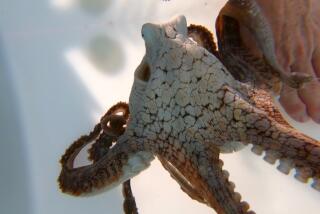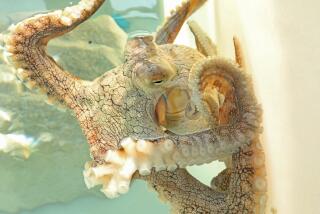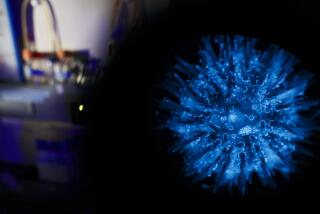At the Kanaloa Octopus Farm, efforts are being made to breed octopus. (Carolyn Cole / Los Angeles Times)
- Share via
KAILUA-KONA, Hawaii — Sandwiched here between the Pacific Ocean and Kona Airport — atop a dusty volcanic desert — dozens of 100-gallon water tanks gurgle and bubble away; each home to a solitary, wild-caught octopus and a couple of floating, plastic bath toys.
Situated on land owned and operated by the Natural Energy Laboratory of Hawaii Authority, the Kanaloa Octopus Farm bills itself as a research institute designed to help tease apart the secrets of the day octopus’ reproductive cycle. Doing so, farm owner Jacob Conroy and his staff say, could help protect the species from overfishing by providing humanity with a stable, captive-bred population of protein-packed cephalopods.
For the record:
11:52 a.m. Dec. 28, 2022Photo captions in an earlier version of this story stated that the Kanaloa Octopus Farm was making efforts to breed octopus for human consumption. Although the facility’s owner has been quoted as saying that in the past, the organization now maintains it is attempting to breed the animals so that they can replace octopuses caught in the wild, or for use by researchers and aquariums. A previous version of this story also stated that the octopus tanks were 50 gallons. The tanks are 100 gallons.
“Right now pretty much every octopus you have ever seen — whether it is the ones you see here today, in an aquarium or even on your dinner plate — have all been wild caught,” said Carmelle Joyner, a farm biologist and tour guide. “There is no method for raising octopus in captivity. This means that we are taking them all from our oceans and our reefs. ... We are hopeful that if we can figure out how to raise them here, our research can be used to apply to other places to help out their natural population.”
But if the prospect of establishing a farmed and sustainable source of octopus — a delicacy of Japanese, Spanish, Portuguese and Mexican cuisines — inspires delight among some diners, Conroy’s farm has come under harsh criticism from those who say keeping octopuses in captivity is cruel.
The farm, which invites visitors to pet the invertebrates — and also features a gift shop stocked with octopus-inspired jewelry and Christmas ornaments — has become ground zero in a growing movement that is demanding humane treatment of these playful sea dwellers.
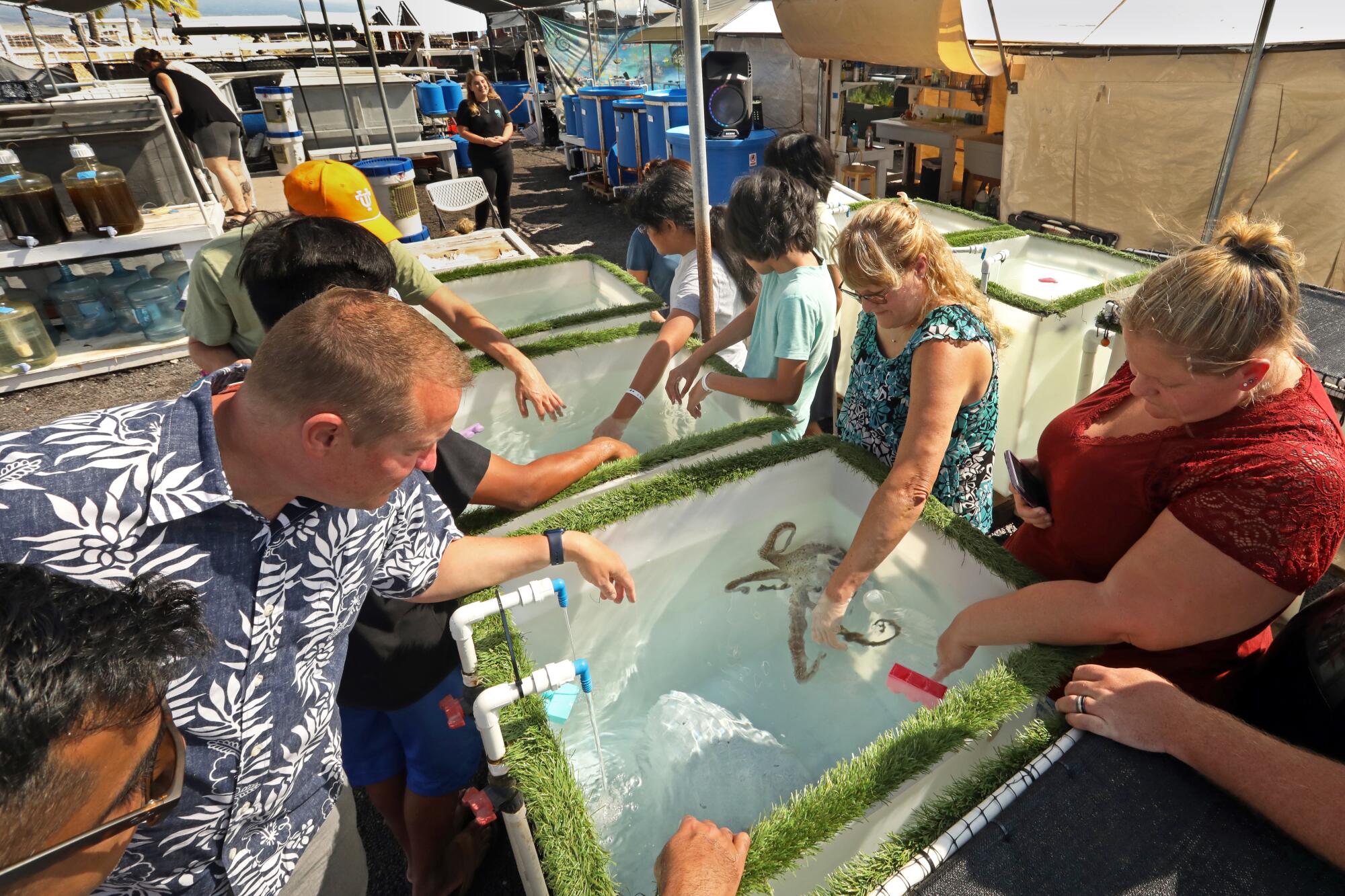
As scientific evidence of octopuses’ intelligence and self-awareness grows, advocates are calling the farm a singular horror show in which wild and curious day octopuses are captured and confined in sterile tanks, where they spend the rest of their short, yearlong lives being poked, prodded and chased by the fingers and hands of gawking, occasionally shrieking, tourists.
“Octopuses are playful, resourceful and inquisitive. They have long-term memories, they use tools and they change the color of their skin for camouflage, but also for communication. They learn through observation. And most importantly they have the capacity to experience boredom,” said Debbie Metzler, director of Captive Animal Welfare at the PETA Foundation. “And yet the Kanaloa Octopus farm confines them to just this series of incredibly small, bleak tanks where they are just used for public interaction. This is exploitation. Not conservation.”
It’s a fight similar to those that have raged over the treatment of veal calves and force-fed geese for foie gras. Critics are asking whether Conroy’s startup and others should keep breeding and confining sentient creatures for a life with no agency, while providing little conservation value — the day octopus is neither endangered nor threatened — and for a food that is marketed predominantly to wealthy people.
Conservationists worry too that widespread farming of octopuses would imperil other sea life, since octopuses require immense amounts of live, fresh-caught crustaceans and fish while also producing large amounts of waste — which just gets dumped back into the ocean, harming nearby coral reefs and habitat.
“I think right now is the time to ask, why are we doing this?” said Jennifer Jacquet, professor of Environmental Studies at New York University. “Is it to feed hungry people? Is it because we absolutely have to?”
“We’re at a crossroads where we can ask ourselves, should we or should we not do this?” said Jacquet.
Conroy did not respond to repeated requests for comment.
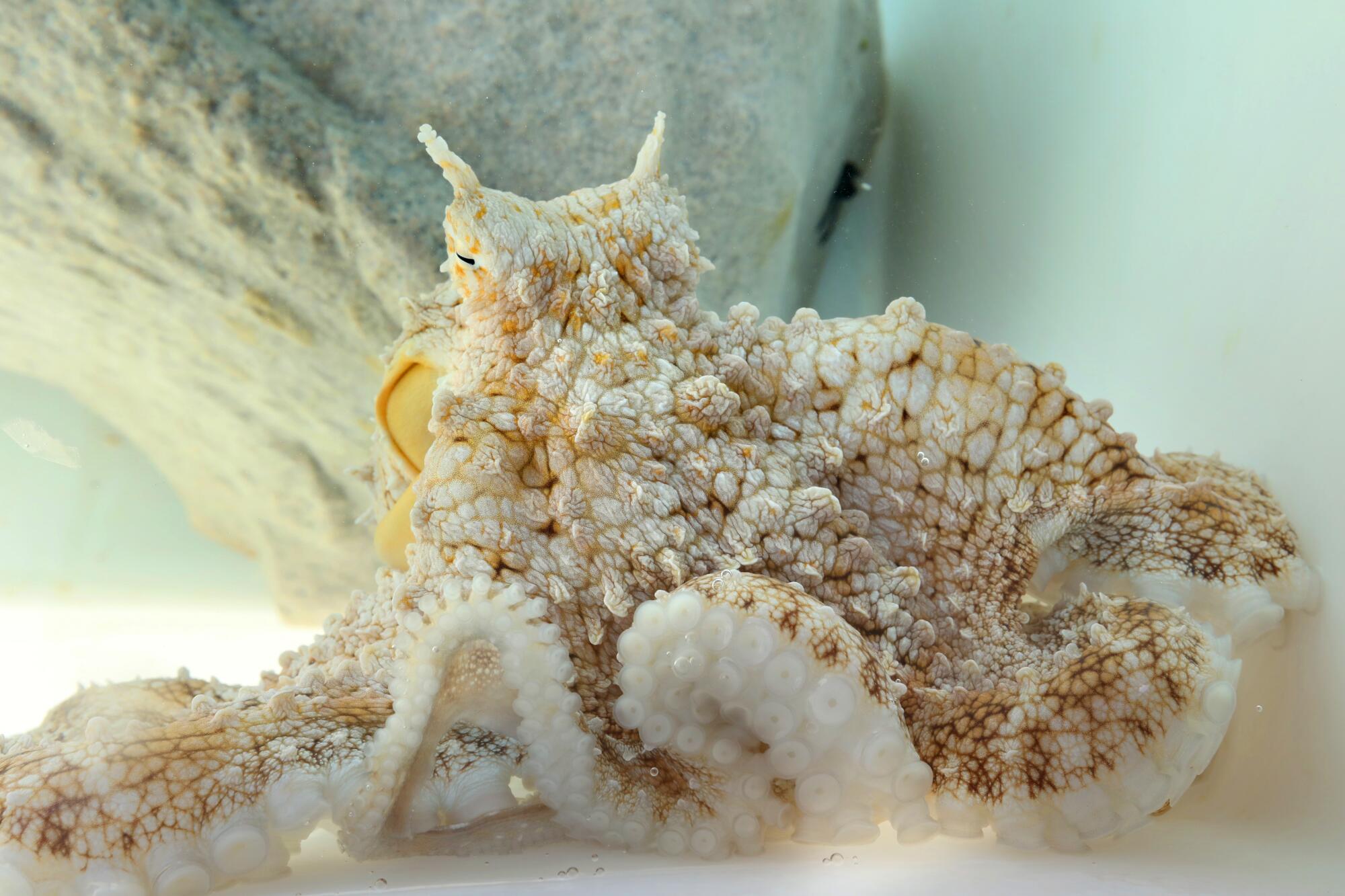
On a Thursday afternoon in October, a reporter and photographer for The Times visited the Kanaloa farm with about two dozen tourists from across the globe.
Most of the outdoor tanks were occupied by solitary day octopuses who’d been caught just off the coast in the days, weeks and months before.
Some were burrowed into the small, plastic cave-like dwellings that sat at the bottom of their tanks — hiding from the hoots and hollers of excitable tourists. Others crawled around the inside walls of their sink, eyeballing their voyeurs and ignoring the two or three plastic bath toys that floated in lazy circles on the surface above them.
Slim Shady — a young male day octopus — reached up and touched the hand of a man who’d been gently splashing the surface, wriggling his fingers just beneath, hoping to make a connection with this alien life form.
“There you go,” said the man soothingly; his hand now wrapped in the embrace of at least two curious tentacles. “That’s a good boy.”
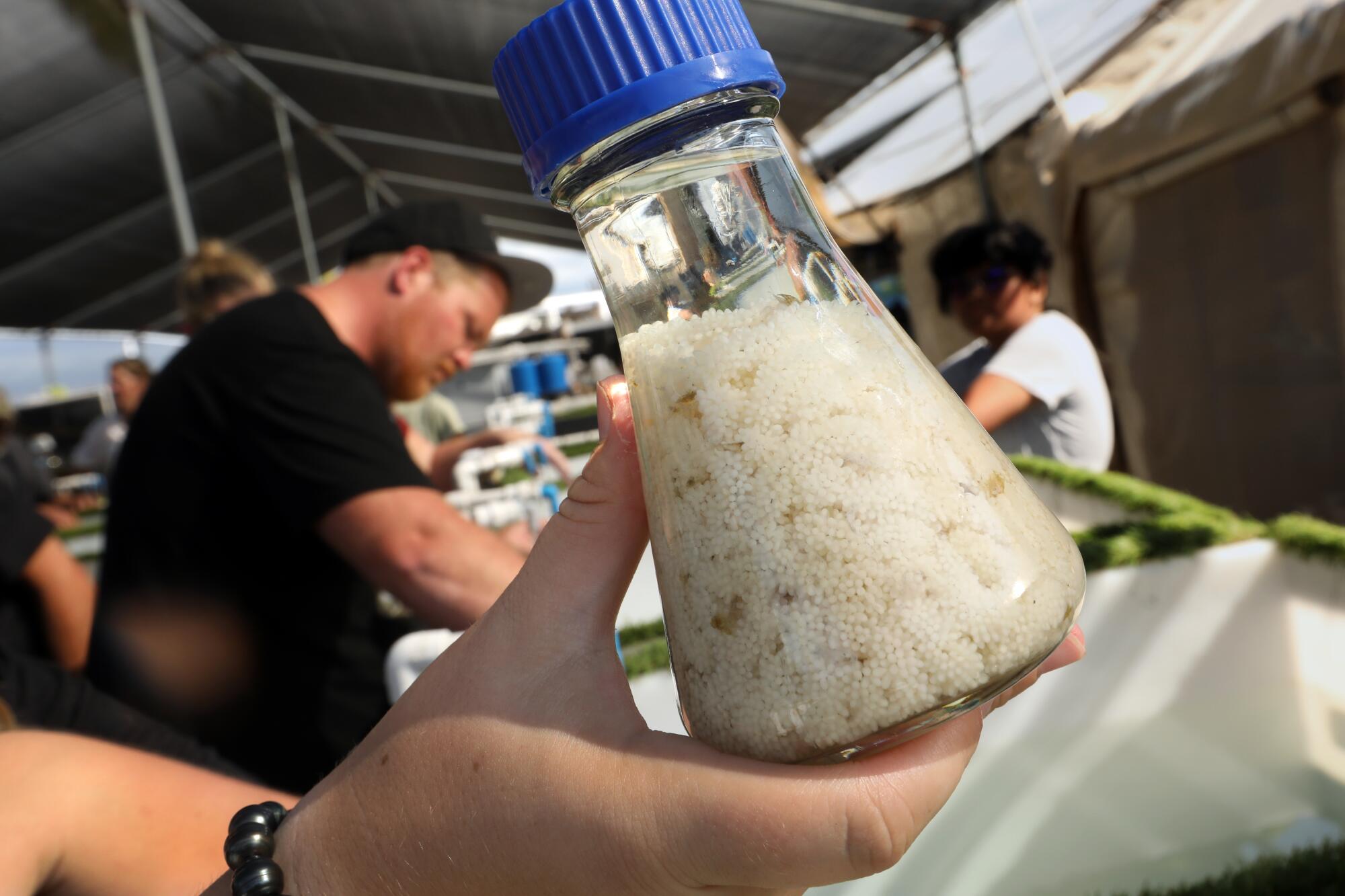
Despite attempts by entrepreneurs such as Conroy and companies such as Nueva Pescanova, in Spain, a successful commercially operating octopus farm does not yet exist. Nobody has yet figured out how to close the octopus life cycle in a commercially desirable species — that is, getting reproductive adults to mate, lay eggs and have offspring that develop into reproductive adults.
The chance that Conroy’s facility or another will someday learn to breed octopuses in captivity, however, still worries animal welfare advocates and conservationists.
“This is a luxury product,” Jacquet said. “It is going to be grown to feed a satiated market that has excess money to buy luxury goods. To me, the octopus farm characterizes extreme excess with no ethical regard for a nonhuman life.”
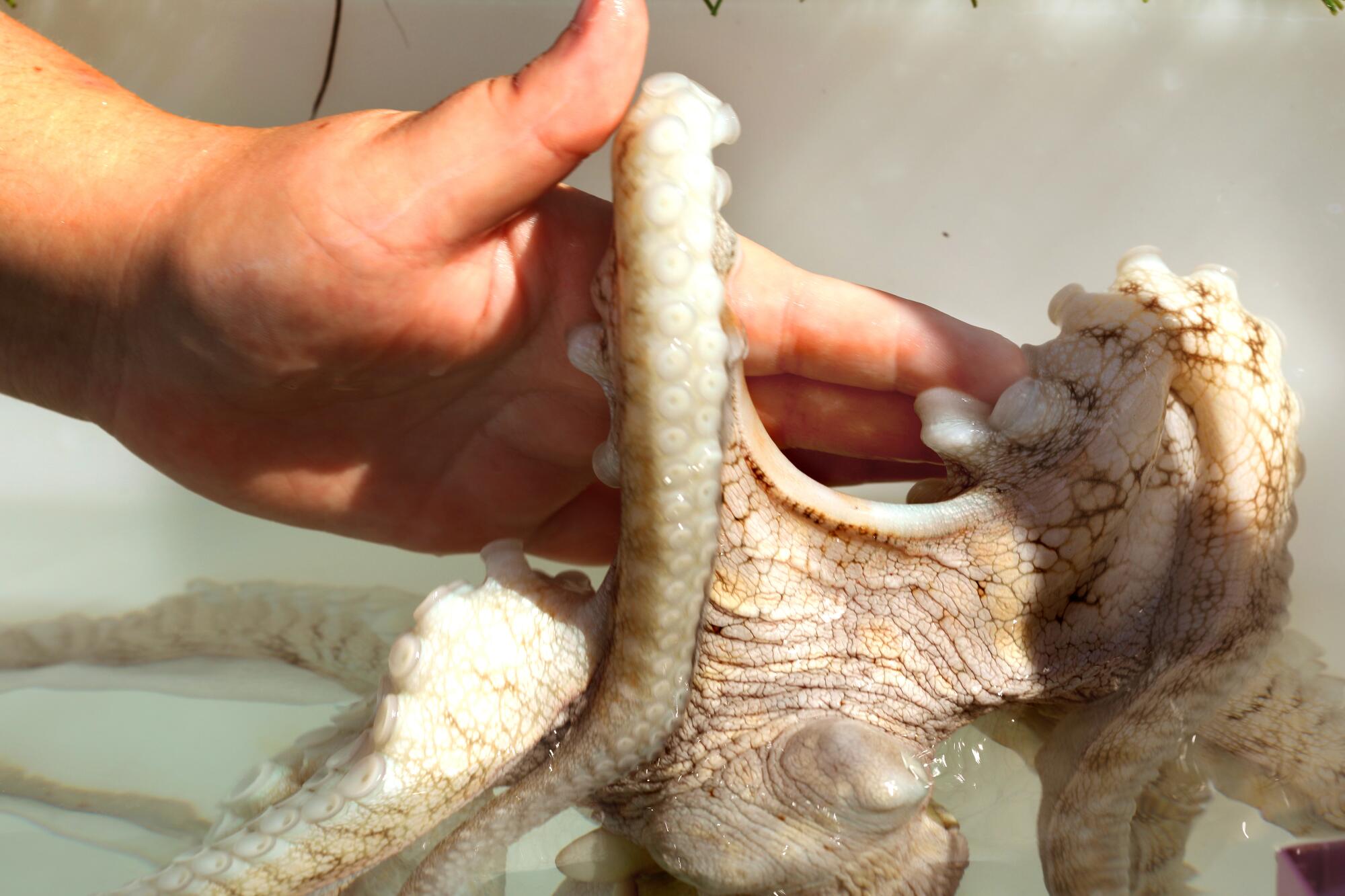
In 2021, researchers at the Marine Biological Laboratory in Woods Hole, Mass., successfully closed the life cycle in the pygmy zebra octopus.
Although that was a first, Robyn Crook, an octopus biologist at San Francisco State University, said the eggs and paralarvae of pygmy zebra octopuses are very different from the kinds commercial farms are hoping to capitalize on.
“Octopuses have two slightly different universes of reproduction,” she said.
Some, like the pygmy zebra octopus, produce a relatively small number of large eggs, “about the size of a pea,” she said.
Others, like the day octopus, or Octopus cyanea, and the common octopus, or Octopus vulgaris, produce hundreds of thousands of very small eggs.
They are desirable because of their high yield, Crook said. It’s just that nobody has figured out how to keep these small hatchlings alive for long.
Joyner, the Kanaloa Octopus Farm biologist, said the facility was trying to determine what the paralarvae hatchlings eat, calling it a “missing piece of the puzzle.” They have been able to keep the paralarvae alive for only 13 days post hatching.
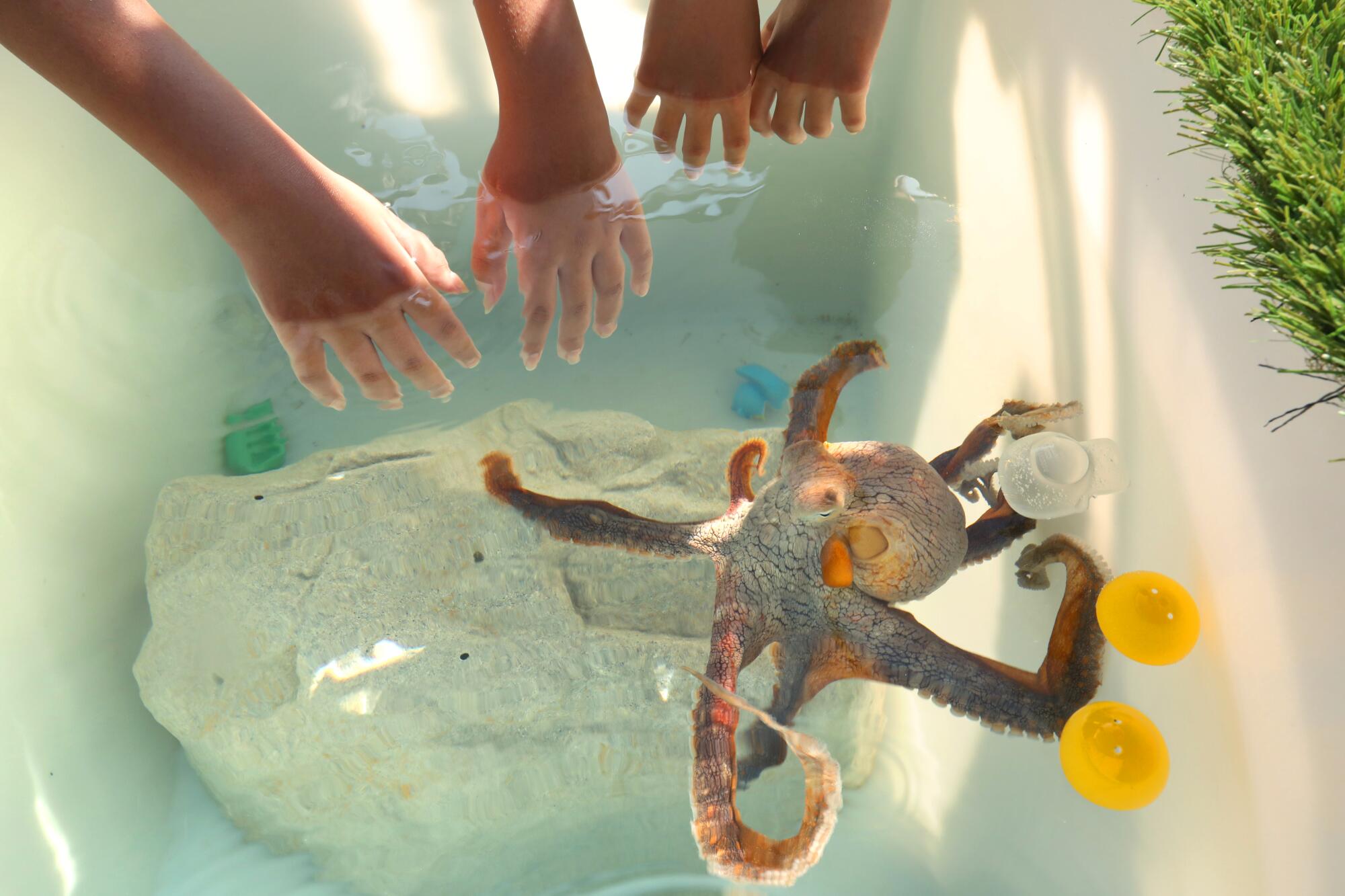
“When these guys hatch out they are about the size of a half a grain of rice. They are very, very small and they are very picky eaters, as well,” she said. “They really only like to eat live foods that are smaller than they are. And unfortunately, at this time, we haven’t figured out exactly what that is.”
But that’s not the only problem facing would-be octopus farmers.
Octopuses are antisocial and “aggressive, so you put two of those guys together in a tank and they’ll kill one another,” said Jacquet. “That would ruin the product.”
Also, octopuses require live food such as fish, crabs and clams to survive.
“Octopuses are very finicky,” said Peter Tse, a neurobiologist at Dartmouth University who studies octopus intelligence. “They really only want to eat living things that they have killed themselves.”
And finally, there’s the issue of pollution. Octopuses produce high levels of nitrogen and phosphorous as waste. That dirty water then gets pumped back into the ocean “and you know — in a sensitive place like Hawaii,” said Jacquet, that can really do some damage.
But most problematic, said the researchers, is the ethical question of whether keeping highly intelligent creatures in sterile tanks for their entire lives is acceptable.
Crook noted that in the United States there are no laws protecting octopuses and other cephalopods, such as squid and cuttlefish; they are not considered animals by the federal government.
Two years ago, a team of legal scholars sent a petition to the National Institutes of Health urging classification of cephalopods as animals. And although Canada, the European Union, the United Kingdom, Australia and New Zealand have laws protecting octopuses, they are still without protections in the United States.
“You need to have much more regulation on what people are doing with sentient creatures. Whether it’s for research. Whether it’s for food production. Or entertainment. There’s a much larger conversation we need to have,” said Kathy Hessler, director of the Animal Legal Education Initiative at George Washington University Law School.
The current lack of legal protections leaves octopuses, like the ones at Kanaloa, vulnerable to inhumane treatment and abuse, said both Hessler and Crook.
“There is very little known about veterinary treatment for octopuses,” said Crook. “Very little about pain relief and nothing at all about humane slaughter. All of these things where we’ve seen big advancements in aquaculture fin fish over the last 20 years, none of that is established for cephalopods.”
Octopuses “are behaviorally complex and they live in a very complex environment and so when we think about what is the right way to keep them in captivity, their environment should replicate that complexity,” she said.
From the photos she has seen of Kanaloa, she sees very little evidence these animals are being provided the stimulation and enrichment their intelligence requires.
“Looks like straight-up tourist attraction to me,” she said.
